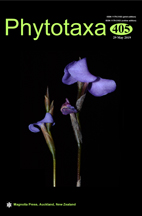Abstract
Didymoplexis Griffith (1844: 383) belongs to a group of morphologically close genera, which also includes Asian genera, Gastrodia R.Brown (1810: 330), Didymoplexiella Garay (1954: 33) and Didymoplexiopsis Seidenfaden (1997: 13). All these plants are small, terrestrial, leafless mycoheterotrophic herbs forming the core of the subtribe Gastrodiinae Lindley (1840: 383) of tribe Gastrodieae Lindley (1821: Appendix), subfamily Epidendroideae Lindley (1821: Appendix). Two-lipped flower and column lacking distinct wings or appendages are main generic characters that distinguish Didymoplexis from related genera of this subtribe. Didymoplexis comprises about 20 species distributed mostly in tropical Africa, Asia, Australia and the Pacific Islands (Zhou et al. 2016, Govaerts et al. 2018). All species of this genus are miniature ephemeral herbs with small, unattractive fugacious flowers opening in one or two in succession and lasting commonly only one day, often only in the morning hours. As a result, representatives of this genus are easily overlooked in botanical surveys, poorly represented in herbaria (where they are often hardly recognized without additional spirit or photographic material) and remain infrequently inventoried in local floras throughout its range. According to available records (Fig. 1), the highest species diversity of Didymoplexis is observed in Java with 6 species (Comber 1990). Thailand (Pedersen et al. 2014) and Borneo (Wood & Cribb 1994, Tsukaya & Okada 2012, Tsukaya et al. 2014, Suetsugu et al. 2017) are inhabited by 5 species each. Three species were hitherto recorded in China (Chen et al. 2009, Lin et al. 2016, Zhou et al. 2016) and Vietnam (Averyanov 2011). Two species were found in Sri Lanka (Fernando & Ormerod 2008) and Laos (Averyanov et al. 2016, 2018). Floras of most other Asian regions such as Afghanistan, India, Nepal, Bhutan, Bangladesh, Myanmar, Japan, Peninsular Malaysia, Sumatra and the Philippines include only one species (Garay & Sweet 1974, Seidenfaden & Wood 1992, Comber 2001, Pearce & Cribb 2002, Kress et al. 2003, Rokaya et al. 2013, Islam et al. 2016). The presence of several species of Didymoplexis in Cambodia is highly possible, despite none of them were recorded there to date. One more species new to science that clearly differs from all hitherto known species of this genus was recently discovered in northern Vietnam, close to the Laos border. Here we describe and illustrate this remarkable plant as Didymoplexis holochelia.

